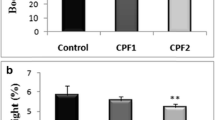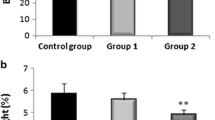Abstract
The induction of hepatic peroxisome proliferation and drug metabolizing enzymes and of sister chromatid exchange (SCE) in lymphocytes was studied in male Han/Wistar rats after exposing them for 2 weeks to a commercial chlorophenolate formulation (Ky-5) (100mg/kg/ day), to 2,3,7,8-tetrachlorodibenzo-p-dioxin (2,3,7,8-TCDD; 0.05–5 μg/kg/wk) and to the pure phenoxyacetic acids, 2,4-dichlorophenoxyacetic acid (2,4-D; 100 mg/kg/day) and 2-chloro-4-methylphenoxyacetic acid (MCPA; 100 mg/kg/day). The chlorophenolate formulation and pure 2,4-D and MCPA caused significant increases in the number of peroxisomes in liver cells, although the average size of peroxisomes was not affected, whereas the effect of even the highest dose of 2,3,7,8-TCDD remained small. This finding indicates that dioxin impurities do not account for the peroxisome proliferation induced by chlorophenolate. The relative weight of the liver increased significantly in rats treated with the chlorophenolate formulation and with 2,3,7,8-TCDD (5.0 and 0.5 μg/kg). The pattern of induction of xenobiotic metabolizing enzymes showed some differences between chlorophenolate treatment and 2,3,7,8-TCDD treatment. Furthermore, the effects of pure phenoxyacetic acids were different from that seen with chlorophenolate and 2,3,7,8-TCDD. The highest dose of 2,3,7,8-TCDD increased the frequency of SCE in circulating lymphocytes slightly, but significantly.
Similar content being viewed by others
References
Aitio A (1978) A simple and sensitive assay of 7-ethoxycoumarin deethylation. Anal Biochem 85: 488–491
Aitio A, Parkki MG (1978) Organ specific induction of drug metabolizing enzymes by 2,3,7,8-tetrachlorodibenzo-p-dioxin in the rat. Toxicol Appl Pharmacol 47: 107–114
Aitio A, Vainio H (1976) UDP glucuronosyl transferase and mixed-function oxidase activity in microsomes prepared by differential centrifugation and calcium aggregation. Acta Pharmacol Toxicol 39: 555–561
Aitio A, Parkki MG, Marniemi J (1979) Different effects of 2,3,7,8-tetrachlorodibenzo-p-dioxin on glucuronide conjugation of various aglycones. Studies in Wistar and Gunn rats. Toxicol Appl Pharmacol 47: 55–60
Beatty P, Neal RA (1976) Induction of DT-diaphorase by 2,3,7,8-tetrachlorodibenzo-p-dioxin (TCDD). Biochem Biophys Res Commun 68: 197–204
Beauchamp C, Fridovich I (1979) Superoxide dismutase: improved assays and an assay applicable to acrylamide gels. Anal Biochem 44: 276
Bergmeyer HU (ed) (1983) Catalase (UV-method). In: Methods of enzymatic analysis. Vol III. Verlag Chemie, Weinheim, pp 273–282
Butterworth BE, Bermudez E, Smith-Oliver T, Earle L, Cattley R, Martin J, Popp JA, Storm S, Jirtle R, Michalopoulos G (1984) Lack of genotoxic activity of di(2-ethylhexyl)phalate (DEHP) in rat and human hepatocytes. Carcinogenesis 5: 1329–1335
Deitrich RA, Bludeau P, Roper M, Schmuck J (1977) Induction of different rat liver supernatant aldehyde dehydrogenases by phenobarbital and tetrachlorodibenzo-p-dioxin. J Biol Chem 252: 6169–6176
deDuve C, Baudhuin P (1966) Peroxisomes (microbodies and related particles). Physiol Rev 46: 323–357
Elovaara E, Savolainen H, Parkki GM, Aitio A, Vainio H (1977) Neurochemical effects of 2,3,7,8-tetrachlorodibenzo-p-dioxin in Wistar and Gunn rats. Res Commun Chem Pathol Pharmacol 18: 487–495
Elovaara E, Marselos M, Vainio H (1983) N,N-Dimethylformamide-induced effects on hepatic and renal xenobiotic enzymes with emphasis on aldehyde metabolism in the rat. Acta Pharmacol Toxicol 53: 159–165
Fridovich I (1976) Oxygen radicals, hydrogen peroxide, and oxygen toxicity. In: Pryor WA (ed) Free radicals in biology, Vol 1. Academic Press, New York, pp 239–277
Hassan MQ, Stohs SJ, Murray WJ (1983) Comparative ability of TCDD to induce lipid peroxidation in rats, guinea pigs, and Syrian golden hamsters. Bull Environ Contam Toxicol 31: 649–657
Hassan MQ, Stohs SJ, Murray WJ (1985) Inhibition of TCDD-induced lipid peroxidation, glutathione peroxidase activity and toxicity by BHA and glutathione. Bull Environ Contam Toxicol 34: 787–796
Hänninen O (1968) On the metabolic regulation in the glucuronic acid pathway in the rat tissues. Ann Aca Sci Fenn Ser A5 142: 1–96
IARC (International Agency for Research on Cancer) (1982) Monographs on the Evaluation of the Carcinogenic Risk of Chemicals to Humans, Suppl. 4, Chemicals, Industrial Processes and Industries Associated with Cancer in Humans. IARC Monographs. Volumes 1–29, Lyon, 292 p
IARC (International Agency for Research on Cancer) (1986). Monographs on the Evaluation of the Carcinogenic Risk of Chemicals to Humans. Vol. 41. Some Halogenated Hydrocarbons and Pesticide Exposures Lyon. 406 p
Kawashima Y, Katoh H, Nakajima S, Kozuka H, Uchiyama A (1984) Effects of 2,4-dichlorophenoxyacetic acid and 2,4,5-trichlorophenoxyacetic acid on peroxisomal enzymes in rat liver. Biochem Pharmacol 33: 241–245
Kligerman AD, Wilmer JL, Erexson L (1981) Characterization of a rat lymphocyte culture system for assessing sister chromatid exchange after in vivo exposure to genotoxic agents. Environ Mut 3: 531–543
Lind C, Hochstein P, Ernster L (1982) DT-diaphorase as quinonine reductase: a cellular control device against semiquinone and superoxide radical formation. Arch Biochem Biophys 216: 178–185
Linnainmaa K (1983) Sister chromatid exchanges among workers occupationally exposed to phenoxy acid herbicides 2,4-D and MCPA. Teratogen Carcinogen Mutagen 3: 269–279
Lowry OH, Rosenbrough HJ, Farr AL, Randall RJ (1951) Protein measurement with Folin phenol reagent. J Biol Chem 193: 265–275
Meister A, Anderson ME (1983) Glutathione. Ann Rev Biochem 52: 711–760
Mäki-Paakkanen J, Husgafvel-Pursiainen K, Kalliomäki P-L, Tuominen J, Sorsa M (1980) Toluene-exposed workers and chromosome aberrations. J Toxicol Environ Health 6: 775–781
Novikoff AB, Novikoff PM, Davis C, Quintana N (1972) Studies on microperoxisomes: IIA cytochemical method for light and electron microscopy. J Histochem Cytochem 20: 1006–1023
Omura T, Sato R (1964) The carbon monoxide-binding pigment of liver microsomes. I. Evidence for its hemoprotein nature. J Biol Chem 239: 2370–2378
Paasivirta J (1978) Chlorophenols-poisons. Possible environmental poisons. Kemia-Kemi 9: 367–370
Pekari K, Aitio A (1982) A simple chromatographic method for the analysis of penta and tetrachlorophenols in urine of exposed workers. J Chromatogr 232: 129–136
Perry P, Wolff S (1974) New Giemsa method for the differential staining of sister chromatids. Nature 251: 156–158
Phillips A, Langdon RG (1962) Hepatic diphosphopyridine nucleotide cytochrome c reductase: isolation, characterization and kinetic studies. J Biol Chem 237: 2652–2660
Pohjanvirta R, Juvonen R, Kärenlampi S, Raunio H, Tuomisto J (1988) Hepatic Ah-receptor levels and the effect of activities in a TCDD-susceptible and resistant rat strain. Toxicol Appl Pharmacol 92: 131–140
Poland A, Knutson JC (1982) 2,3,7,8-Tetrachlorodibenzo-p dioxin and related halogenated aromatic hydrocarbons: examination of the mechanism of toxicity. Ann Rev Pharmacol Toxicol 22: 517–554
Rao MS, Reddy JK (1987) Peroxisome proliferation and hepatocarcinogenesis. Carcinogenesis 8: 631–636
Rappe C, Marklund S, Buser HR, Bosshard HP (1978) Formation of polyclorinated dibenzo-p-dioxins (PCDDs) and dibenzofurans (PCDFs) by burning or heating chlorophenates. Chemosphere 7: 269–281
Reddy JK, Lalwani ND (1983) Carcinogenesis by hepatic peroxisome proliferators: evaluation of the risk of hypolipidemic drugs and industrial plasticizer to humans. Crit Rev Toxicol 12: 1–58
Reddy JK, Qureshi SA (1979) Tumorigenicity of the hypolipidemic peroxisome proliferator ethyl-α-p-chloro-phenoxyisobutyrate (clofibrate) in rats. Br J Cancer 40: 476–482
Reddy JK, Rao MS (1977) Malignant tumors in rats fed nafenopin, a hepatic peroxisome proliferator. J Natl Cancer Inst 59: 1645–1650
Reddy JK, Azarnoff DL, Hignite CE (1980) Hypolipidaemic hepatic peroxisome proliferators form a novel class of chemical carcinogens. Nature 283: 397–398
Saville B (1958) A scheme for the colorimetric determination of microgram amounts of thiols. Analyst 83: 670–672
Stohs SJ, Hassan MO, Murray WJ (1983) Lipid peroxidation as a possible cause of TCDD toxicity. Biochem Biophys Res Commun 111: 854–859
Tappel AL (1978) Glutathione peroxidase and hydroperoxides. Meth Enzymol 52: 505–513
Vainio H, Nickels J, Linnainmaa K (1982) Phenoxy acid herbicides cause peroxisome proliferation in Chinese hamsters Scand J Work Environ Health 8: 70–73
Vainio H, Linnainmaa K, Kähönen M, Nickels J, Hietanen E, Marniemi J, Peltonen P (1983) Hypolipidemia and peroxisome proliferation induced by phenoxyacetic acid herbicides in rats. Biochem Pharmacol 32: 2775–2779
Warren JR, Simmon VF, Reddy JK (1980) Properties of hypolipidemic peroxisome proliferators in the lymphocyte H3 thymidine and Salmonella mutagenesis assays. Cancer Res 40: 36–41
Author information
Authors and Affiliations
Rights and permissions
About this article
Cite this article
Mustonen, R., Elovaara, E., Zitting, A. et al. Effects of commercial chlorophenolate, 2,3,7,8-TCDD, and pure phenoxyacetic acids on hepatic peroxisome proliferation, xenobiotic metabolism and sister chromatid exchange in the rat. Arch Toxicol 63, 203–208 (1989). https://doi.org/10.1007/BF00316369
Received:
Revised:
Accepted:
Issue Date:
DOI: https://doi.org/10.1007/BF00316369




